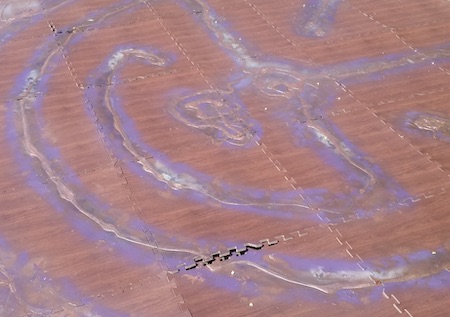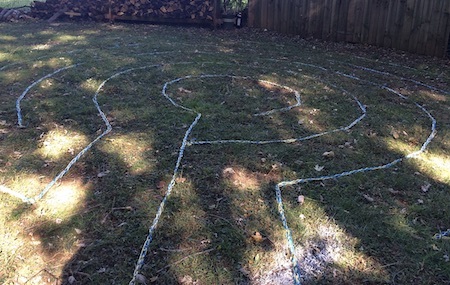Introducing the Labyrinth to Others
You may recognize a need for using a labyrinth in your work (see our Labyrinth as a Tool page for examples and guidance for using the labyrinth in particular areas). Alternatively, you may wish to bring a labyrinth to your community, place of worship, or organisation. Or, you may feel inspired to begin a labyrinth practice, where you offer to host walks for different groups of people, or in occasional workshops that you host.
Below, you will find information and links to sources of guidance to support introducing the labyrinth in each of these areas. Simply click on the item in the list below that you want to view.
![]() Considerations for introducing a labyrinth to groups and orgnaisations
Considerations for introducing a labyrinth to groups and orgnaisations
![]() Making or buying a labyrinth
Making or buying a labyrinth
![]() Situating and orienting a labyrinth
Situating and orienting a labyrinth
![]() Funding a labyrinth project
Funding a labyrinth project
![]() World Labyrinth Day
World Labyrinth Day
Considerations for introducing a labyrinth to groups and orgnaisations
Introducing a labyrinth to any group of people may start as simply as offering an opportunity to walk a portable labyrinth. In some cases, such "one-off" events as part of festivals, or being hosted by visiting labyrinth enthusiasts, have encouraged communities (clubs, churches, community committees, and more) to set about investigating whether they might create a temporary or permanent labyrinth of their own.
Some decide to build their own labyrinth–perhaps one mowed into grass, marked out in an outdoor area with stones, or painted onto a floor. Some have made or purchased temporary labyrinths of canvas or other materials that can be regularly rolled out for walks. These events are sometimes combined with an opportunity for walkers to gather after to share their reflections, and to socialize. Others have launched campaigns to fund and commission installations by professional labyrinth builders.
In the latter case , permissions and significant funding may be involved, likely including a proposal to convince those involved in making decisions about such things that the venture is worthwhile. This may involve describing how the labyrinth is intended to offer benefits(for example, in a healthcare setting, referencing research into demonstrated health benefits of labyrinth walking). However, for less ambitious projects, this need not be the case.
Labyrinths that are to be laid out more-or-less permanently need to be carefully situated, whether indoor or outdoor. They should ideally be on even surfaces, constructed in a way that minimizes harm from wind, rain, and heat (for example, a concreted path needs to cater for drainage, and be laid in such a way to avoid excessive cracking with variations in temperature, and the possible affects of ice).
Some individuals pay special attention not only to the siting of a labyrinth, but also to the orientation of its entrance and placement of its center. In the Christian faith tradition, for example, it's normal to orientate the entrance to point toward the east–the direction of the rising sun. Others dowse the siting and orientation, believing that a labyrinth will reveal its divined location by this means.
When a labyrinth is to be walked for the first time, it's common to dedicate or offer a blessing for the labyrinth, its role in the community, or purpose it will serve. This may take the form of a simple ceremony honoring the labyrinth's gift and power. Readings, prayers, or simply words of positive intent might be included.
Dedication and launch events may be a particular cause for promotion. Posters, flyers, social media posts, press releases, and word-of-mouth may all play a part in bringing about awareness of the labyrinth. Once established, word-of-mouth mentions from individuals who have experienced the labyrinth may become more important.
Labyrinths that are permanently accessible in outdoor locations often attract attention from passers-by. Since these may be walked at any time, and be unhosted, a small sign explaining what a labyrinth is, and some basic guidelines for walking, may help encourage newcomers to step onto its path. Information leaflets protected by a small box might achieve the same purpose.
Beyond creating and making a labyrinth available, attention might also be given to how it might be regularly used in a field of work, or for building community relations. For example, a hosted walk offered at a set time each week, followed by an opportunity for walkers to informally share after their walk, can be a powerful way to encourage community sharing.
Click here to return to top of page.
Making or buying a labyrinth
You may prefer to set about creating a labyrinth of your own, whether for a group, or for your own personal use. Examples abound of labyrinths that have been formed with paving stones in backyards, cut into lawns, or painted onto playgrounds.
Baltic, medieval, and classical labyrinth patterns can be drawn relatively easily with the aid of some basic knowledge and a few basic tools (such as a tape measure, and a length of string). Their outline can be quickly replicated by working from what is known as a "seed pattern", a simple blueprint of a design that's mapped out close to the labyrinth's center. The diagram below illustrates the process for drawing a classical style labyrinth, building up from such a pattern.

A range of YouTube videos, books, and other materials describe how to mark out different labyrinth designs, including:
The Labyrinth Society, classical and medieval labyrinths
Discover Labyrinths. Extensive collection of videos, showing how to draw and make various types of labyrinth.
The Transition Labyrinth Video by Jamie Edmonds, showing how to create a labyrinth on the beach.
Grass labyrinth Video illustrating a labyrinth being cut into a grass lawn.
Creating a five-Circuit Chakra Vyhua labyrinth shows how to create a temporary labyrinth in a matter of minutes.
Making a canvas labyrinth shows how a canvas labyrinth was painted.
Chalk yard labyrinth shows how to chalk out an 11-circuit labyrinth in a back yard or school playground.
Make a plaster finger labyrinth shows how to create a plaster finger labyrinth.
Most of the videos listed above are in the English language. Please let us know if you come across others, or make one of your own, in your own language.
Pop-up labyrinths are ones that are intended to be set up and then dismantled after a single event. These may be created using a wide range of inexpensive materials. Rope, tape, candles, and chalk lines are among possibilities for marking out a temporary path. A labyrinth that's cut into a beach, snow, or the soil of an uncultivated field need not cost anything at all to make, even if it may not be very long lasting.
Polycanvas and acrylic are especially popular as base materials for portable labyrinths, offering good protection against the weather.


Labyrinths painted on carpet tiles, and marked out with crocheted rope
Rope labyrinth image © Carol Maurer
However, virtually any material will suffice for creating an indoor labyrinth that will have relatively limited use, especially if walkers take care to respect the damageable nature of the material that they are walking on (for example, by removing their shoes before stepping on to it).
If you don't wish to experiment with creating a portable labyrinth of your own, help can be obtained from a number of well established labyrinth makers (a number of whom are listed here). Many of these can also assist with creating artwork for designs other than the more common patterns. For example, the work of Lisa Moriarty (Paths of Peace) includes examples of labyrinths that incorporate a tree illusion branch motif, or are focused around a heart-shaped center, among others.
Projects to introduce labyrinths in a public space, as well as in such places as university grounds, corporate campuses, and rest homes, may call for a more permanent installation. Such projects typically require larger budgets, and will be greatly assisted by drawing on the expertise of a specialist labyrinth builder.
Even here, costs can often be minimized where volunteers are ready to become involved in the project. For example, some labyrinths have been introduced as part of community gardening or Venture Scout project. The opportunity for members of a community who will walk a labyrinth to be involved in their creation can be a powerful way to engage interest and participation.
Click here to return to top of page.
Funding a labyrinth project
For a significant, permanent labyrinth project, much time and effort may be involved to persuade others that the project is worthwhile. This may involve referring to the expected benefits of providing a labyrinth (for example, referencing research cited by The Labyrinth Society), establishing funding needs, applying for planning permission, commissioning and/or organizing the construction of the labyrinth. Possible grants, organization or government funding, and voluntary financial contributions such as crowdsourcing may be sought.
The following proposal template (in English), developed by the University of Oklahoma and offered by The Labyrinth Society, may be useful for creating proposals for funding labyrinths for community and wellbeing purposes.
Click here to return to top of page.
Several individuals have succeeded in bringing about significant labyrinth projects through their perseverence, vision, and encouraging others. For example, the sandstone Medieval Labyrinth in Centennial Park, Sydney, Australia was the vision of one remarkable woman, Emily Simpson. With donations from an inspired community, this labyrinth now plays an important role in a major public space in the city. Listen to Emily's story in Emily Simpson The lady of the Labyrinth (Karen Swain ATP Radio podcast, plays immediately. In English).
Other labyrinth projects have been planned by one individual, but brought together many hands at a single time to construct a labyrinth in a publicly accessible space. For example, numerous examples exist of soil and stone labyrinths planned as part of a Venture Scout's special project. Following planning and working out how the labyrinth will be constructed, a group of scouts and other volunteers have then usually come together, often completing the digging and marking out of a labyrinth in a single day.
Situating and orienting a labyrinth
Some people believe that there's no "correct" way to determine where a labyrinth should be situated, nor which direction its entrance should face. Some do believe that dowsing, intuition, or other methods should be used to make such choices. Others believe that practical considerations, such as working around trees, finding the flatest ground, and positioning the entrance where it may give the easiest access, are more relevant for deciding where to position a new labyrinth.
Tradition, symbolism, or ritual may also play a part–for example, labyrinths associated with most Christian churches are usually aligned so that walkers enter from the west direction, facing toward the "rising sun" (and Christ) that first appears in the east.
Geomancy, which is concerned with understanding the energies of the Earth, and so what might most suitably be placed where, and Feng shui, are subjects that you may wish to explore (the following article explains the difference between these two: Geomancy vs. Feng Shui). The website of Sig Longeren, Mid-Atlantic Geomancy, offers much information on this subject.
Other excellent sources of information about geomancy and dowsing include:

 Marko Pogačnik, UNESCO Artist for Peace (in Croatian and English)
Marko Pogačnik, UNESCO Artist for Peace (in Croatian and English)
 Tony Christie, dowser, spiritual teacher, author, labyrinth builder, artist, consultant, and inspirational teacher (in English)
Tony Christie, dowser, spiritual teacher, author, labyrinth builder, artist, consultant, and inspirational teacher (in English)

 Karmit EvenZur, geomancer and storyteller (in Spanish and English). See also the website,
Karmit EvenZur, geomancer and storyteller (in Spanish and English). See also the website, 
 Earth Speaks, which offers courses in geomancy, among other offerings
Earth Speaks, which offers courses in geomancy, among other offerings


 Gea Viva, center for geomancy and for art (in Croatian, German, and English)
Gea Viva, center for geomancy and for art (in Croatian, German, and English)
 Adventures in Dowsing, podcast, hosted by geomancer Grahame Gardner (in English)
Adventures in Dowsing, podcast, hosted by geomancer Grahame Gardner (in English)
 Marty Cain, artist, labyrinth designer, and geomancer (in English)
Marty Cain, artist, labyrinth designer, and geomancer (in English)
 Earth Energy Network, blog and Facebook community (English, UK-based)
Earth Energy Network, blog and Facebook community (English, UK-based)

 Lifenet, international community of geomancers (in German and English)
Lifenet, international community of geomancers (in German and English)
If trusting where to site a labyrinth using dowsing, you might have a sense that it is not always meant to put a labyrinth in a particular place–there may already be something that's unseen about the place, such as earth energies that are at work, that may mean that it doesn't neeed to be, or isn't meant to be, there.
Whether or not you wish to enquire into the significance of geomancy, it is worth considering whether the planned site for the labyrinth is close to electricity power lines, mobile phone transmitters, or other channels for high energy. These can distract from the energy focus of a labyrinth.
The initial turn of a labyrinth may be either clockwise or counter-clockwise. A symbolic meaning in some beliefs, or an intuition, or divined (typically, dowsed) orientation, may determine the direction. Otherwise, there appear to be as many labyrinths that follow a clockwise as a counter-clockwise direction (although clockwise patterns seem to be more popular in recent years).
World Labyrinth Day
World Labyrinth Day is an annual event held each May, sponsored by The Labyrinth Society. On this day, at 1 o'clock in their own time zone, individuals are invited to "walk as one at one".
World Labyrinth Day can provide an excellent opportunity for publicizing a labyrinth event and engaging interest in the labyrinth in your community.
Find out more about World Labyrinth Day by clicking here.
Click here to return to top of page.
Supporting labyrinth lovers worldwide.









